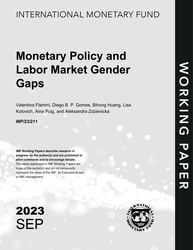
Monetary Policy and Labor Market Gender Gaps
Monetary Policy and Labor Market Gender Gaps
READ MORE...
Volume/Issue:
Volume 2023
Issue 211
Publication date: September 2023
ISBN: 9798400257292
$20.00
Add to Cart by clicking price of the language and format you'd like to purchase
Available Languages and Formats
| English |
Prices in red indicate formats that are not yet available but are forthcoming.
Topics covered in this book
This title contains information about the following subjects.
Click on a subject if you would like to see other titles with the same subjects.
Labor , Economics- Macroeconomics , Economics / General , Gender Studies , Monetary policy , shocks , gender inequality , labor market , unemployment , labor force participation , monetary policy shock , gender employment gap , gender labor force participation gap , labor market gender gaps , men employment , employment gender gaps , Labor markets , Employment , Women
Also of interest
Summary
We study the effects of monetary policy shocks on employment gender gaps in a panel of 22 countries using quarterly data from 1990 to 2019. Our results show that men’s employment falls more than women’s after contractionary monetary policy shocks, narrowing the employment gender gap over time. Two factors contribute to explaining this heterogeneous effect. First, a larger impact of monetary policy shocks on employment in the industry sector that employs more men. Second, the larger response of the employment gap in the sector (services) that employs the largest share of men and women. In terms of labor market adjustment, the narrowing of the gender employment gap is initially driven by a reduction in the gender unemployment gaps that, over time, results in an adjustment in the gender labor force participation gap—with men’s labor force participation dropping more than women’s. The effects are larger in countries with more flexible labor market regulations, higher gender wage gaps, and lower informal women’s employment compared to men’s. Finally, the effects are also larger for contractionary monetary policy shocks and during expansions.
Copyright © 2010 - 2025
Powered by:
AIDC



